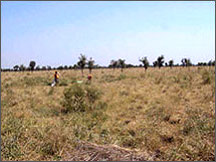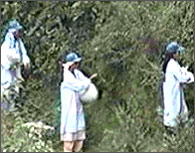- About us
- Quality
- Infrastructure
- Team
- Laboratory
- Packaging
- Why us?
- FAQ's
- Send Enquiry
• Natural Henna
• Mahogany Hair Color
• Burgundy Hair Color
• Golden Brown Hair Color
• Chestnut Brown Hair Color
• Natural Black Hair Color
• Orange Hair Color
• Lemon Hair Color
Home
» About Henna
» Henna Farming in India
Henna Farming in India
Henna
is a flowering plant of around 2-6 m in height native to tropical and
subtropical regions of Africa, southern Asia, and northern Australasia in
semi-arid zones. In India, depending upon the rainfall and temperature seven
climatic regions are there. Eastern areas receive heavy rainfall, western
areas are dry, northern areas are very cold while southern areas are
tropical. Therefore, growth of henna and its farming is perfect for some
regions and impossible in others.
Agriculture cycle in India is created by the monsoon system with establishing and harvesting determined by summer monsoon rainfall. Rajasthan in India is a droughty region where 250mm or less than it, rainfall occurs. Henna crops in these areas are may be smaller in size but contain higher dye content. For the perfect growth and farming of henna it is better that it is sown in dry soil as if it is sown in moist soil then henna plant will be attacked by Corticium koleroga (Black rot disease) and by Xanthomonas lawsonieae (Bacterial leafspot) which will damage the crop and diminish yield.
Henna grows throughout most of India as it is a major commercial crop cultivated mainly in the northwestern states where the climate is relatively hot and dry. All across India, due to global warming summer highs have increased. In the farming process of henna, farmers prefer hot, arid areas where it is found to be reliable cash crop. Favorable conditions for high quality henna crops is " hotter and dryer weather with prolonged droughts ".
Major Areas of Farming
Henna crops stay for long time in the ground throughout the harvesting period with no need for plowing. It helps in maintaining productive farmland by holding the delicate dry topsoil in place. Some areas in India where farming of quality henna is done are Gujarat, Madhya Pradesh, Punjab and Rajasthan. Henna serve different purposes in these areas like in Gujarat and Punjab henna is mostly sold as hair dye, in Rajasthan it is often popularly used as body art and in Madhya Pradesh it is harvested for hair coloring and for making perfume oils rather than body art.
Henna Farm at Rajasthan
Rajasthan western and semi arid regions like Sojat and the surrounding areas in the Pali district get less than 400 - 500 mm rainfall annually, therefore considered as the most intensive henna cultivation region in India. Around 90% of henna production is in this area. For generations, farmers have produced henna in this area regarded as a desirable crop as well as part of their heritage.
Indian Henna Export Cities
The major henna crop export cities in India are Delhi, Udaipur, Jodphur, Jaipur, Calcutta, Mumbai and Ahmadabad.
Agriculture cycle in India is created by the monsoon system with establishing and harvesting determined by summer monsoon rainfall. Rajasthan in India is a droughty region where 250mm or less than it, rainfall occurs. Henna crops in these areas are may be smaller in size but contain higher dye content. For the perfect growth and farming of henna it is better that it is sown in dry soil as if it is sown in moist soil then henna plant will be attacked by Corticium koleroga (Black rot disease) and by Xanthomonas lawsonieae (Bacterial leafspot) which will damage the crop and diminish yield.
Henna grows throughout most of India as it is a major commercial crop cultivated mainly in the northwestern states where the climate is relatively hot and dry. All across India, due to global warming summer highs have increased. In the farming process of henna, farmers prefer hot, arid areas where it is found to be reliable cash crop. Favorable conditions for high quality henna crops is " hotter and dryer weather with prolonged droughts ".
 |
 |
Major Areas of Farming
Henna crops stay for long time in the ground throughout the harvesting period with no need for plowing. It helps in maintaining productive farmland by holding the delicate dry topsoil in place. Some areas in India where farming of quality henna is done are Gujarat, Madhya Pradesh, Punjab and Rajasthan. Henna serve different purposes in these areas like in Gujarat and Punjab henna is mostly sold as hair dye, in Rajasthan it is often popularly used as body art and in Madhya Pradesh it is harvested for hair coloring and for making perfume oils rather than body art.
Henna Farm at Rajasthan
Rajasthan western and semi arid regions like Sojat and the surrounding areas in the Pali district get less than 400 - 500 mm rainfall annually, therefore considered as the most intensive henna cultivation region in India. Around 90% of henna production is in this area. For generations, farmers have produced henna in this area regarded as a desirable crop as well as part of their heritage.
Indian Henna Export Cities
The major henna crop export cities in India are Delhi, Udaipur, Jodphur, Jaipur, Calcutta, Mumbai and Ahmadabad.
Send
Enquiry
About
Us || Quality || Infrastructure
|| Team || Laboratory
|| Packaging || Why
us? || FAQ's || || Send Enquiry
Copyright 2019
NaturalHairColors.com. All rights reserved.